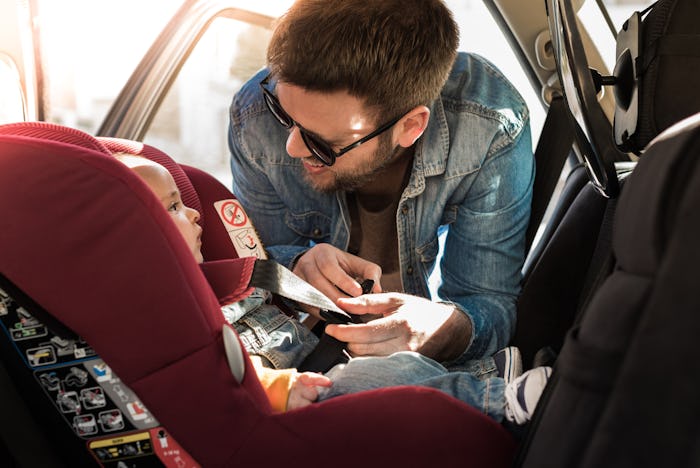As a parent, keeping your kids safe is your most important responsibility, but it can also be the most daunting one. Guidelines and recommendations from experts are updated all the time, and just when you think you finally know what you're doing, you have to learn it all over again. That's why all parents need to see these car seat infographics, because if you're relying on outdated information, you might be putting your child at risk without even realizing it. Your firstborn might have gotten the go-ahead to face forward at 12 months, for example, but these days, the recommended age is 2 — and that's only assuming they've hit the height and weight limits for their particular seat.
If you're a first time parent, you might be overwhelmed with all the different car seat choices. Should you get a convertible seat that grows with your baby, or a travel system that can plug into a base in your car or your partner's, as well as a stroller? Should you use the seatbelt to secure it, or is the LATCH system better? What's the difference between a car seat and a booster seat? Do you need a high-back booster, or backless? And why is this all so complicated?
Don't sweat it; you've got this. As long as you know your kid's height and weight, and remember their birthday, it's actually fairly simple to figure out what kind of seat they should be in.
Car seat guidelines are roughly based on age, but there's no one-size-fits-all rule, because kids come in all shapes and sizes. If you can, it's best to wait until your child meets all the criteria — age, height, and weight — before for moving up to the next seat. If you feel that they can't, ask your pediatrician for advice. Some parents might want to turn a particularly tall 18-month-old to front-facing because they're concerned about legroom, but kids are very flexible, and it's fine if they have to bend their knees in a rear-facing seat. According to the American Academy of Pediatrics, leg injuries in rear-facing seats are very rare.
As far as the style of rear-facing seat goes, that's a matter of personal preference. If your baby will be riding in more than one car frequently, an infant seat that snaps into a base might be the best choice for you, so you're not regularly removing and reinstalling the seat. If you'd prefer to save some money down the road, a convertible or all-in-one seat can last for years. For booster seats, choose a high-back at least until your child is tall enough for your car's shoulder belt to align properly across their body. According to Consumer Reports, some backless boosters have shoulder belt positioning guides, as well, but they don't do as good of a job as a high-back.
Once you've got the right seat, it's just as important to make sure that you're using it properly. In any seat with a back — rear-facing, forward-facing, or booster — your child's head should be no less than one inch below the top of the seat. Seat backs can usually be adjusted, so check often to make sure they haven't outgrown the current setting. Car seat straps should be snug against your child's chest. "If you can pinch the straps of the car seat harness," the AAP cautions, "then it needs to be tightened." Once your child is in a booster, make sure it's positioning the seat belt over their shoulder and lap, as opposed to their neck or stomach. And never install a car seat in front of an airbag.
If you're traveling or moving out of state with your child, make sure that you're in compliance with local laws. Some states only require kids to ride in a car seat up to age 5, but most require one until age 7, and two require them up to age 8. And it's worth noting that there's concrete evidence that staying in a car seat longer results in fewer preventable deaths and injuries, so even if your state is a little more laissez faire about traffic safety, it's a good idea to keep your kid in a car seat or booster as long as possible.
Finally, make sure that your child is properly restrained in the car every time. Even for short trips. Even if they're hungry and you're just going to breastfeed for a minute. Even if your first-grader is completely mortified that they're still in a car seat while all the other kids in class are in boosters, or just seat belts. Because that last image up there represents thousands of children under 12 that died in car accidents, many of whom would have survived if they'd been in the proper seat. There can be no exceptions where safety is concerned.
Watch Romper's new video series, Romper's Doula Diaries:
Check out the entire Romper's Doula Diaries series and other videos on Facebook and the Bustle app across Apple TV, Roku, and Amazon Fire TV.
